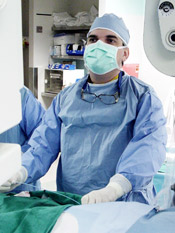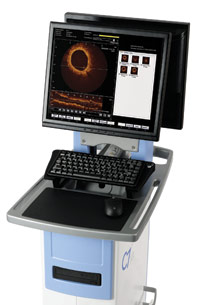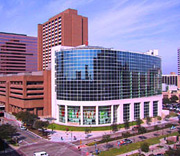THI Cardiologists Use Breakthrough Imaging to
Better Diagnose and Treat Patients With Blocked Arteries
Houston, Texas (January 18, 2011)—
Texas Heart Institute (THI) at St. Luke's Episcopal Hospital (SLEH) cardiologists recently became the first in Houston to implement a new imaging tool that shows unprecedented detail of arteries, allowing interventional cardiologists to make more informed decisions when assessing and treating heart arterial blockages.
 |
| Dr. Emerson Perin during a cardiac catheterization procedure. |
The cutting-edge technology, known as Optical Coherence Tomography (OCT), enables physicians to be extremely precise when performing such heart procedures as placing a stent to unblock an artery. The high-resolution images can be especially important in assessing stent placement by clearly showing how the stent is holding the artery open and whether it is positioned correctly against the artery wall, optimizing treatment and follow-up strategies.
"The enhanced precision should result in better outcomes for patients," said Emerson Perin, MD, director of cardiovascular research at THI. "OCT is a diagnostic tool that allows a physician to understand the composition of a heart blockage."
Perin was among the first cardiologists to treat patients with OCT at SLEH, beginning December 16. He also researched the technology at THI prior to its being approved by the FDA in May 2010 for use in the United States.
"We have developed a good understanding of how OCT works and know it really well," Perin said, noting that other THI interventional cardiologists are rapidly adopting the new technology.
 |
| Optical Coherence Tomography (OCT) C7-XR System |
OCT—already used in Europe and Japan—is employed in conjunction with heart catheterization procedures, including angioplasty, in which a cardiologist uses a tiny balloon on the tip of a catheter to unblock an artery in the heart. Most patients who undergo balloon angioplasty also receive a stent—a small mesh-like device placed inside the artery to keep the vessel open.
Before performing angioplasty, a cardiologist may use intravascular ultrasound, which utilizes sound waves to send back images showing where blockages are located in heart arteries and where to place the stent. Rather than using sound waves, OCT forms images by reflecting light inside blood vessels, allowing the cardiologist to see 10 times more detail than with intravascular ultrasound technology.
Perin added, "We are now able to clearly see the plaque, determine how much fat or clot there may be in an artery and take precise measurements before and after placing stents. The technology is also fast and easy to use."
In its OCT research, THI focused on the side branches of coronary arteries and the effects of stenting. After a stent is placed, tissue from the lining of an artery typically grows around the stent. THI observed how much of a stent became covered with tissue and how much remained bare. This is important, Perin said, because an artery with an exposed metal stent is more prone to forming blood clots. The THI STEM Cell Center funded the research because circulating STEM cells comprise the tissue that grows around a stent.
THI assessed OCT against a scanning electron microscope, which also produces very high-resolution images, and determined that OCT is comparable to that technology.
The OCT technology at SLEH is the C7-XR System, developed by LightLab Imaging and recently acquired by St. Jude Medical. It utilizes near-infrared light to create images.
For THI and St. Luke's media profiles, see
Public Affairs.



